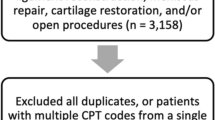Abstract
Septic arthritis is a potential catastrophic complication of intra-articular steroid injection. There is lack of evidence regarding the precautions that should be taken to avoid such a complication, as well as how often it is encountered. The aim of this study was to evaluate the antiseptic precautions taken during intra-articular steroid injection of the knee in the United Kingdom (UK), and estimate how often septic arthritis is encountered by health professionals in the UK following steroid injection of the knee. A questionnaire was posted to 100 orthopaedic surgeons, 100 rheumatologists and 50 general practitioners (GPs), asking them about the cases of septic arthritis following intra-articular steroid injection of the knee that they encountered during their practice and the precautions they take when injecting knees. The response rate was 76.4%; 57.6% of the respondents used alcohol swabs to clean the skin, and the remaining 42.4% used chlorhexidine or Betadine. Only 16.3% used sterile towels to isolate the injection site. There were 32.5% of respondents who routinely used sterile gloves when injecting, and a total of 46.6% used either sterile or non-sterile gloves. Also, 91.1% changed needles between drawing the steroid and injecting it into the joint. Only 24 respondents (12.6%) had encountered septic arthritis after steroid injection of the knee (18 once, 3 twice, 2 three times, 1 several times). We concluded that septic arthritis post intra-articular steroid injection of the knee is probably rare. There is a wide variation in the precautions taken to avoid such a complication. However, the trend seems to be towards minimal use of antiseptic techniques. Further large prospective studies are needed to determine how frequently septic arthritis of the knee is encountered post steroid injection, and the exact precautions that should be taken to avoid it.
Similar content being viewed by others
References
Von Essen R, Savolainen HA (1989) Bacterial infection following intra-articular injection – a brief review. Scand J Rheumatol 18:7-12
Gedda PO (1954) Septic arthritis from cortisone. JAMA 155:597
Hollander JL (1970) Intrasynovial corticosteroid therapy in arthritis. Maryland State Med J 19:62–66
Gray RG, Tenenbaum J, Gottlieb NL (1981) Local corticosteroid injection therapy in rheumatic disorders. Semin Arthritis Rheum 10:231–254
Fitzgerald RH Jr (1976) Intrasynovial injection of steroids: uses and abuses. Mayo Clin Proc 51:655–659
Kendall H (1963) Local corticosteroid injection therapy. Ann Phys Med 7:31–38
Gowans JDC, Granieri PA (1959) Septic arthritis: its relation to intra-articular injections of hydrocortisone acetate. N Engl J Med 261:502–503
Peters RH, Rasker JJ, Jacobs, JW, Prevo RL, Karthaus RP (1992) Bacterial arthritis in a district hospital. Clin Rheumatol 11:351–355
Kaandrop CJ, van Schaardenburg D, Krijnen P (1999) Antibiotic prophylaxis of haematogenous bacterial arthritis. Ned Tijdschr Geneeskd 143:1808–1811
Kaandrop CJ, Dinant HJ, van de Laar MA, Moens HJ, Prins AP, Dijmans BA (1997) Incidence and sources of native and prosthetic joint infection: a community based prospective survey. Ann Rheum Dis 56:470–475
Kaandrop CJ, Van Schaardenburg D, Krijnen P, Habbema JD, van de Laar MA (1995) Risk factors for septic arthritis in patients with joint disease. A prospective study. Arthritis Rheum 38:1819–25
Cawley PJ, Morris IM (1992) A study to compare the efficacy of two methods of skin preparation prior to joint injection. Br J Rheumatol 31:847–8
American College of Rheumatology, Council on Rheumatological Care (1992) Safety guidelines for performing arthrocentesis. Available from: URL: http://www.rheumatology.org/position/safetyguide.html
Maitra AK, Adams JC (1986) Use of sterile gloves in the management of sutured wounds in the A&E department. Injury 17:193–5
Bodiwala G, George TK (1982) Surgical gloves during wound repair in the Accident and Emergency department. Lancet ii: 1216
Author information
Authors and Affiliations
Corresponding author
Appendix 1
Appendix 1
Cost for minimally antiseptic technique (cost of steroid not included)
One needle | 1.55p |
One 10 ml syringe | 5.38p |
One pair of non-sterile gloves | 4.58p |
One alcohol swab | 0.91p |
Total | 12.42p |
Cost for full antiseptic technique (cost of steroid not included)
Two needles | 3.1p |
One 10 ml syringe | 5.38p |
One pair of sterile gloves | 22.00p |
50 ml of Betadine | 12.8p |
Small sterile towel | 7.76p |
Small sterile container (for Betadine) | 1.43p |
Sterile cotton wool pack of four (used to apply Betadine) | 10.00p |
Total | 62.47p |
The above costs were obtained from the Autumn 2001 NHS logistics catalogue and from the accounting department of the Manchester Royal Infirmary. The cost of local anaesthetic is not included in either estimate.
Rights and permissions
About this article
Cite this article
Charalambous, C.P., Tryfonidis, M., Sadiq, S. et al. Septic arthritis following intra-articular steroid injection of the knee – a survey of current practice regarding antiseptic technique used during intra-articular steroid injection of the knee. Clin Rheumatol 22, 386–390 (2003). https://doi.org/10.1007/s10067-003-0757-7
Received:
Accepted:
Published:
Issue Date:
DOI: https://doi.org/10.1007/s10067-003-0757-7




